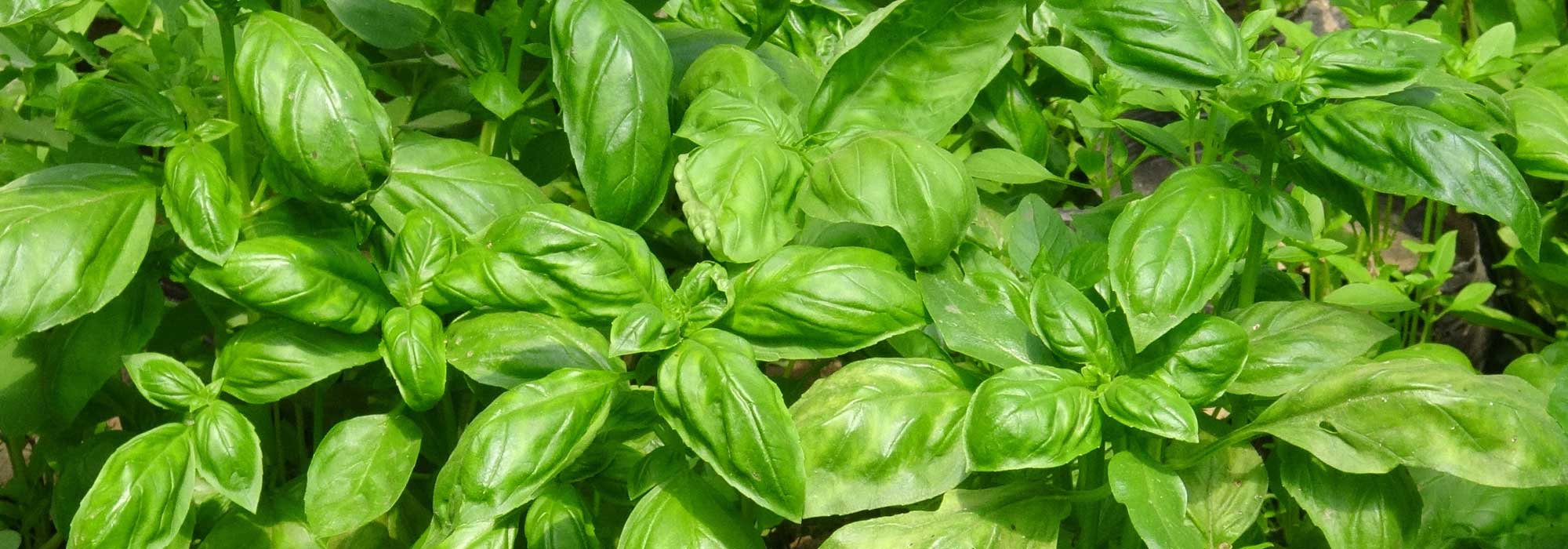
Basil: sowing, planting, growing
Contents
Basil in a nutshell
- Basil, Ocinum basilicum, is an annual aromatic plant
- It can be grown in the garden but can also be planted in pots, on the terrace or balcony
- Its cultivation is easy but it loves heat and sunlight
- Its maintenance consists of regular pruning and watering in case of drought
- Highly valued in cooking, basil is the essential ingredient of the famous Italian pesto
The word from our expert
Basil is an aromatic plant essential for the garden. Its fragrant leaves are widely used in cooking, particularly in Italian cuisine but also in Asian dishes, such as Thai Basil. It is also a plant with numerous benefits, stimulating digestion.
We are familiar with ‘Grand Vert’ basil and ‘Fin vert’ basil, but much less so with the other varieties. And there are many! They are distinguished by their habit, which can be more or less compact, the size of their leaves, and their colour, which ranges from green to purple, sometimes almost black, as seen in the ‘Dark Opal’ variety. All exude pleasant fragrances with well-defined nuances, which is their main appeal!
Easy to grow, basil cultivation is within reach of all gardeners, even those without a garden, as it grows very well in pots. It enjoys sun and warmth and thrives in good humus-bearing, well-drained soil… as it fears excessive moisture.
Basil sowing is generally done in a warm place, at home or in a heated shelter. It should only be planted, in the garden or in pots, outside after the Ice Saints, once all risk of frost has passed. Indeed, it is not hardy and is therefore sensitive to cold. Basil maintenance is simple: just harvest it regularly and water it in case of prolonged drought.
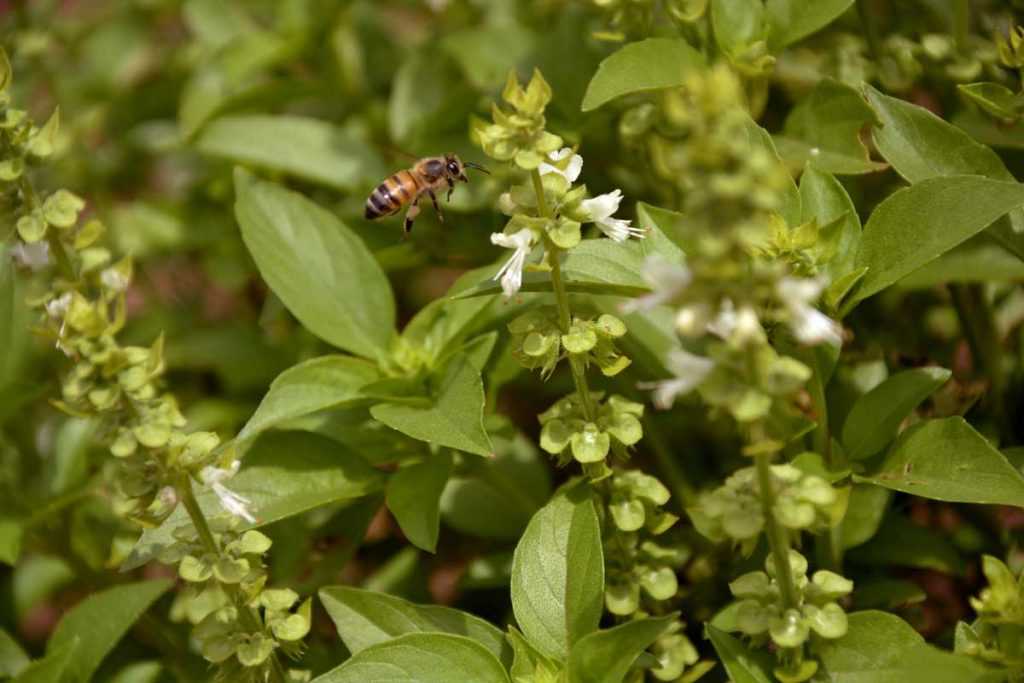
Basil is a melliferous plant
Description and botany
Botanical data
- Latin name Ocimum basilicum
- Family Lamiaceae
- Common name Basil
- Flowering Annual
- Height 10 days at 20°C - Germination capacity
- Exposure Sun
- Soil type Rich, humus-bearing, draining
- Hardiness 0°C, it dies at the first frosts
European Basil (Ocimum basilicum) is an aromatic herb native to the Pacific Islands and Africa. It is an herbaceous plant that grows 30 to 60 cm tall and 20 to 40 cm wide, depending on the variety and growing conditions.
The stems are upright, ramified with a square section, a typical character of the Lamiaceae formerly known as Labiate. These stems bear ovate leaves 3 to 5 cm long. Their size and colour vary depending on the variety: they can be very large or very small and show a green or purple coloration, more or less intense.
In the middle of summer, the flower spikes of basil rise and bear spikes of small white or mauve flowers. They require the presence of insects to transport the pollen and carry out the pollination. The fertilised flowers develop into small seeds, each surrounded by a receptacle that dries out at ripeness in September and October. The seeds then fall to the ground quite easily.
The use of basil in the Mediterranean basin dates back to antiquity. Among the Romans, this plant was the emblem of lovers, while among the Greeks, it symbolised hatred and misfortune. In India, basil is considered a sacred plant!
Read also
Sowing of aromatic plantsThe main varieties
There are many varieties of basil. They are distinguished by their colour (purple, green), the size of the leaf, but also by their fragrance and habit, which can be more or less compact.
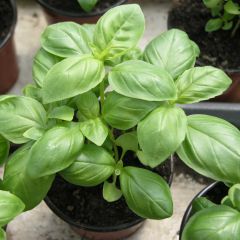
Genovese Basil
- Height at maturity 50 cm

Sweet Basil Organic - Large leaf Italian Basil
- Height at maturity 50 cm
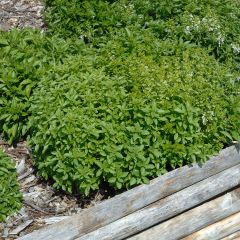
Basil Fino Verde - Bush basil
- Height at maturity 50 cm
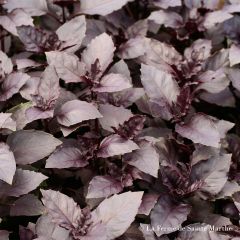
Organic Purple Basil - Ferme de Sainte Marthe seeds
- Flowering time July to October
- Height at maturity 30 cm
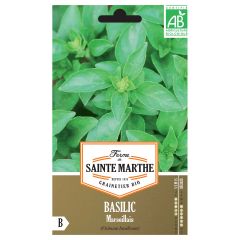
Marseille Basil - Ferme de Sainte Marthe Seeds
- Flowering time July to October
- Height at maturity 30 cm
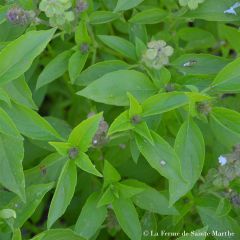
Anise Basil - Ferme de Sainte Marthe seeds
- Flowering time July to October
- Height at maturity 30 cm
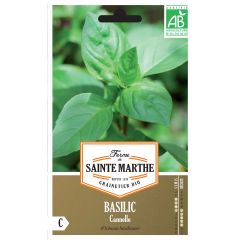
Cinnamon Basil - Ferme de Sainte Marthe seeds
- Flowering time July to October
- Height at maturity 30 cm
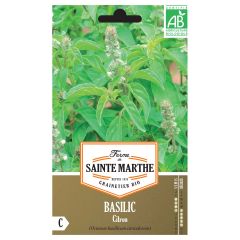
Lemon Basil - Ferme de Sainte Marthe seeds
- Flowering time July to October
- Height at maturity 30 cm
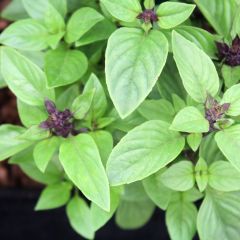
Thai Basil - Ferme de Sainte Marthe Seeds
- Flowering time July to October
- Height at maturity 30 cm
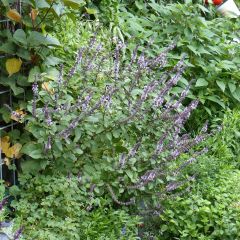
Perennial Magic Mountain Basil in seedlings
- Flowering time July to September
- Height at maturity 40 cm
Discover other Basil plants
View all →Available in 0 sizes
Available in 2 sizes
Available in 2 sizes
Available in 1 sizes
Available in 1 sizes
Available in 1 sizes
Available in 1 sizes
Available in 1 sizes
Available in 1 sizes
Available in 1 sizes
Sowing basil
Start sowing basil warmly, at home or in a heated shelter, from February to April. Sowing can be done either in individual buckets or in trays. From May onwards, sowing is done directly in the ground. The bottom of the tray or pots should have small drainage holes to remove excess water. On average, it takes about 10 days for germination, at an average temperature of 20°C, out of direct sunlight.
- Fill the seed tray two-thirds full with seed compost and lightly firm it down with a trowel.
- Place the seeds, leaving at least 2 cm between each seed.
- Cover with seed compost to the thickness of the seeds using a sieve (ideally) and lightly firm it down with a trowel.
- Lightly water using a water spray bottle.
To encourage germination, cover the seed tray with a glass. Ventilate during the day by lifting the glass when the seedlings appear.
For sowing in trays, carefully transplant the seedlings into buckets when they have more than three true leaves (the first two leaves that appear after sowing are the cotyledons and are not counted). Keep the plants protected from frost.
Read also
How to sow basil?Planting basil
Plants from warm sowing must be hardened for at least two weeks to outdoor temperatures and direct sunlight during the day, then brought in or sheltered at night. This hardening phase allows for a smooth transition; indeed, plants that have experienced ideal conditions indoors since germination need to gradually acclimatise to direct sunlight, fluctuating temperatures, and inclement weather. This way, basil can avoid excessive stress when it is finally planted in the vegetable garden. After this acclimatisation phase, they can be planted in the vegetable garden.
Planting in the vegetable garden begins when the risk of frost has passed. This period extends from mid-April to the end of May, depending on the regions and the year’s weather. Traditionally, it is considered that sensitive plants (like basil) can be planted after the Ice Saints, that is, after 13 May.
As basil is a sun-loving , ensure it has a warm and sunny location. In the South, provide it with a spot that is partially shaded.
When planting, allow for an spacing of 25 cm between two plants. As with sowing, planting should be done in loosened and weeded soil. To plant:
- Dig a hole that matches the size of the plant
- Place your basil plant in the hole
- Fill the gaps with soil
- Water for the first time. Rainwater warmed in the sun will be beneficial.
Basil cultivation, care and watering
Soil and exposure
Basil loves the sun, and partial shade in the hottest regions. It can be grown in a wide range of soil but prefers humus-bearing, well-draining and cool soils.
It is planted, whether from seeds or plants, in previously loosened and well-weeded soil. To do this, loosen the soil using a broad fork or spading fork, taking care to remove any weeds and adventive plants.
Basil maintenance and watering
Dryness tends to cause basil to flower, to delay this phenomenon:
- Cut the tops of the stems
- Ensure to water regularly with preferably tepid rainwater
- Pinch the flower spikes to stimulate the production of new leaves.
- Add a nutrient-rich mulch made of dried clippings
→Read also: Our best tips for successfully growing basil.
Companion planting with basil
In the vegetable garden, a good companion planting is to plant basil between each tomato plant. The roots of basil excrete substances that will protect tomatoes from nematodes. These are called nematicidal substances as they kill nematodes, microscopic worms that parasitise the roots of tomatoes and deplete the plants until, sometimes, their death.
It is also and above all a very practical association, as tomatoes and basil are harvested in the same place, ideal for making a summer salad full of flavours!
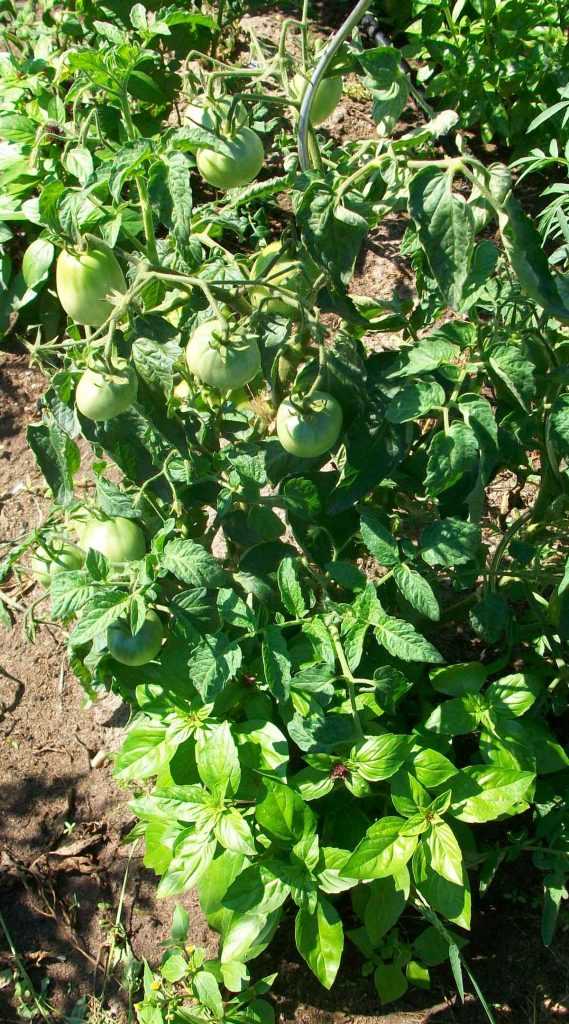
Potted basil
Basil is an easy and practical plant to grow in a pot, here’s how to proceed:
- Place one to two centimetres of clay balls or pumice at the bottom of the pot (with drainage holes) for drainage.
- Fill your pot with universal potting soil, which you can enrich with your homemade compost, at a ratio of 1/3 compost to 2/3 potting soil.
- Transplant the young plants, counting one plant every 5 cm.
- If you are sowing directly in the pot, sow more seeds and thin them out later to keep the best plants.
- Water lightly using a water spray bottle.
When the plants have taken well, water from the top or soak your pots in water warmed in the sun, preferably rainwater.
In spring, when temperatures are sufficiently warm, the pots can be placed outside, on a windowsill, balcony, or terrace. As in the vegetable garden, choose a sunny or slightly shaded spot and ensure that the soil does not dry out too much.
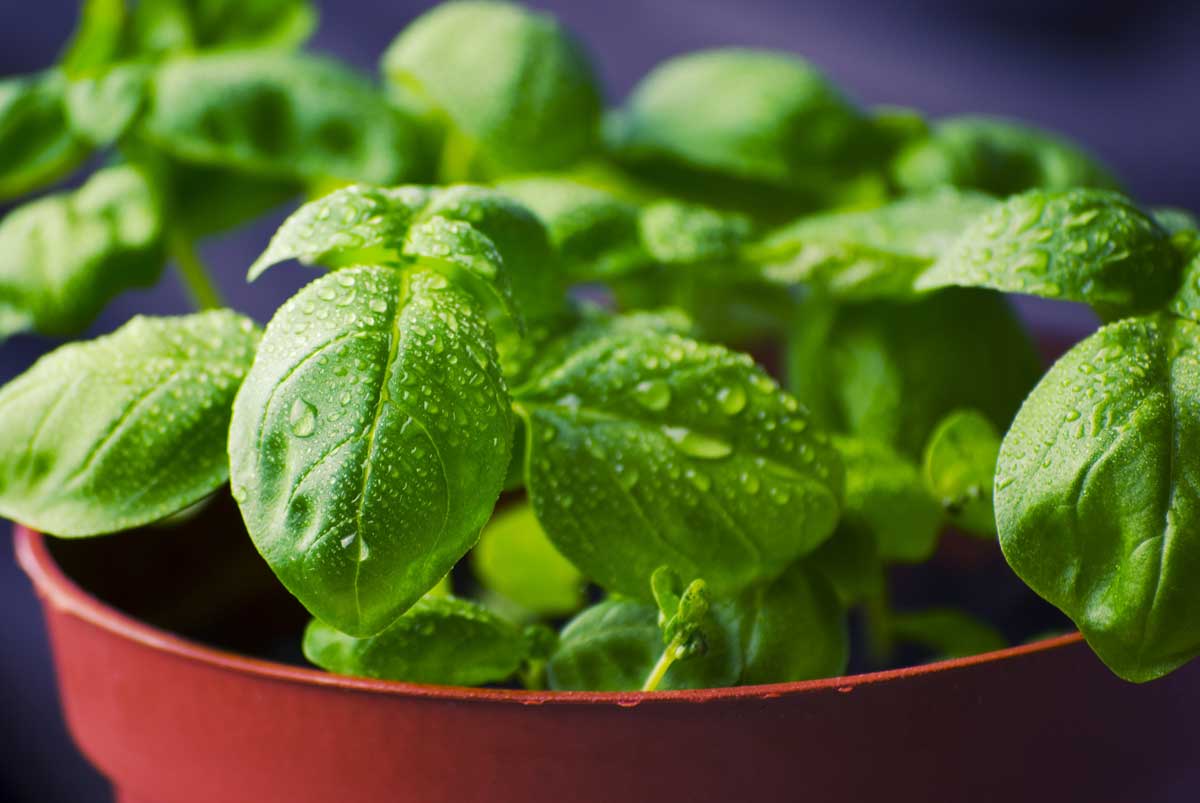
Basil grown in a pot
Sowing in pots takes place from spring to the end of summer. To have pots of basil by the end of the year, sow in August outside. The basil plants will have time to soak up the sun, and then you can bring them inside before the first cold weather (in October), placing them preferably on a sunny windowsill.
If you start with plants purchased from a shop, do not hesitate to cut half of the stems before repotting the plant. This operation will stimulate your plant to produce new roots and new shoots.
A well-maintained pot of basil will provide about four months of harvest. During the growing season, add a gentle and natural fertiliser such as dried coffee grounds, which you will mix equally with potting soil or garden compost, then top the pot with a good centimetre of this mixture.
Harvesting and storing Basil
Harvesting Basil
From early summer to autumn, harvest the leaves as needed by simply cutting them by hand or with scissors.
To extend the harvest sustainably, we encourage the basil to produce new shoots. To do this, we regularly (and whenever possible) pick the terminal clusters, which allow for the development of new shoots. The secondary stems take over the growth, keeping the plant dense, sturdy, and ramified, while also delaying flowering.
In the first photograph, two young shoots can be seen in the axil of the leaves and stem (under the pair of scissors). By cutting the main stem at this level, the two shoots take over, and a few days later, this is clearly visible (second photo).
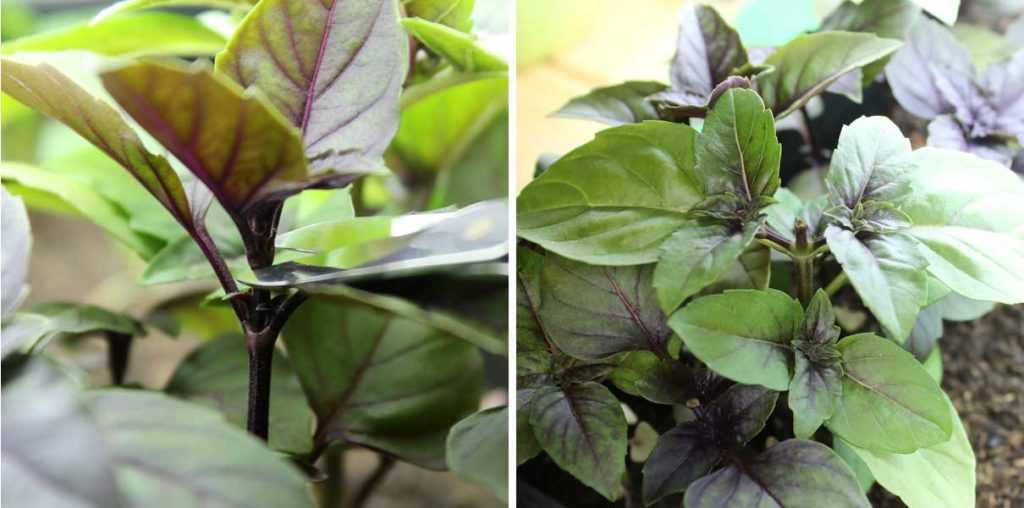
1) Cutting the terminal shoot 2) The shoots located in the axil of the stem take over
Storing Basil
After harvesting, basil leaves do not keep long and tend to blacken. Ideally, it should be harvested fresh as needed. Here are some good storage methods:
To store basil for about a week, cut stems and place them in a glass filled with water. The water should be changed every couple of days to prevent the leaves from yellowing and the stems from rotting.
To store basil leaves for about a year, it is possible to dry the leaves on racks until they lose as much moisture as possible; they should be completely dry and crumble easily. They are then stored in airtight containers away from light.
Freezing is also an option; a simple and practical technique is to chop the leaves and place them in ice cube trays, covering them with water before freezing.
Finally, and most importantly, you can prepare pistou and pesto, two recipes that allow you to keep basil for a few days in the refrigerator or several months in the freezer.
Usage – Some recipes
Using basil in cooking
Basil is widely used in Mediterranean cuisine as well as in Asian cooking, with its fresh or dried leaves consumed in salads, marinades, or sauces (pesto) accompanying pasta, meat, or fish (sea bream à la varoise).
Pistou and pesto are two essential recipes featuring basil, but they are quite distinct:
- Pesto, developed in the late 19th century in Italy (Genoa), is traditionally made with Genovese basil. Other ingredients include olive oil, parmesan or pecorino cheese, garlic, and pine nuts.
- Pistou is the legacy of pesto when it arrived in Provence. The recipe consists of preferably Marseille basil, garlic, and olive oil. Pine nuts and cheese are optional in pistou.
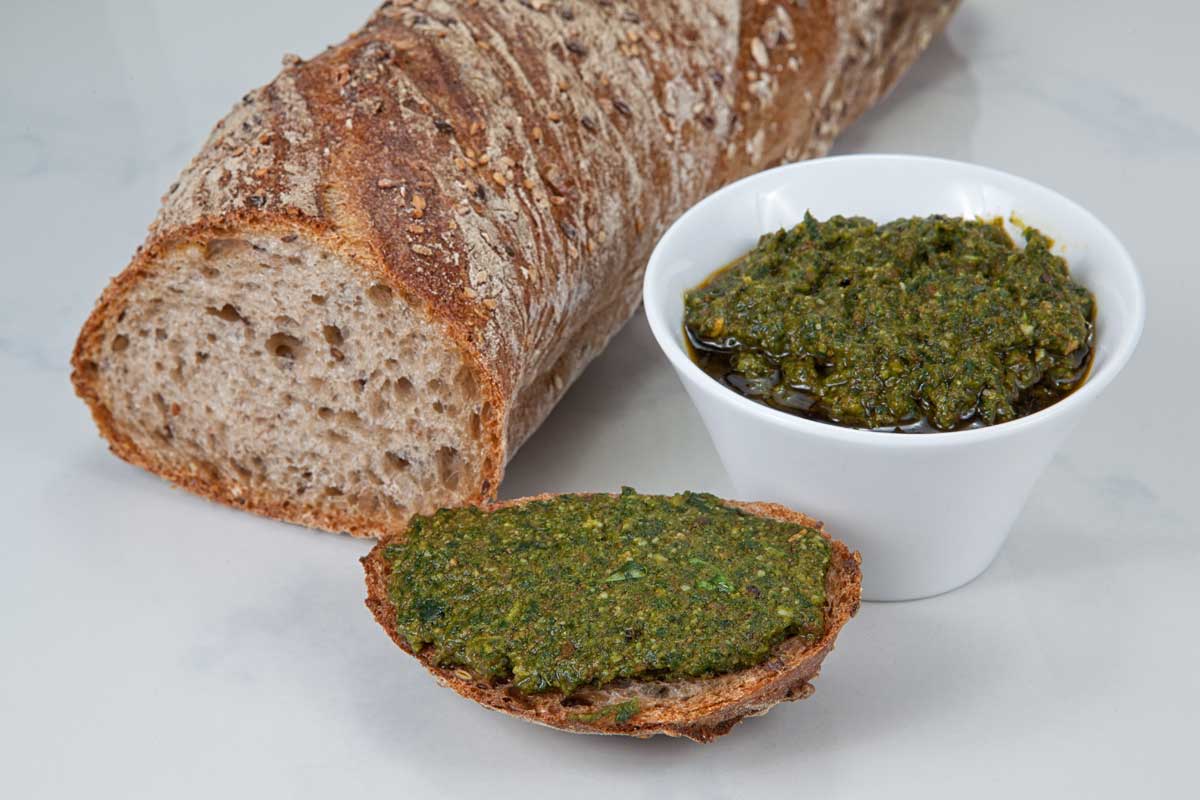
The essential pesto!
- Caprese Salad
The famous Italian Caprese salad (tomato mozzarella) is made from sliced tomatoes and mozzarella arranged alternately. It is sprinkled with finely chopped basil leaves and seasoned with a drizzle of quality olive oil, salt, and pepper.
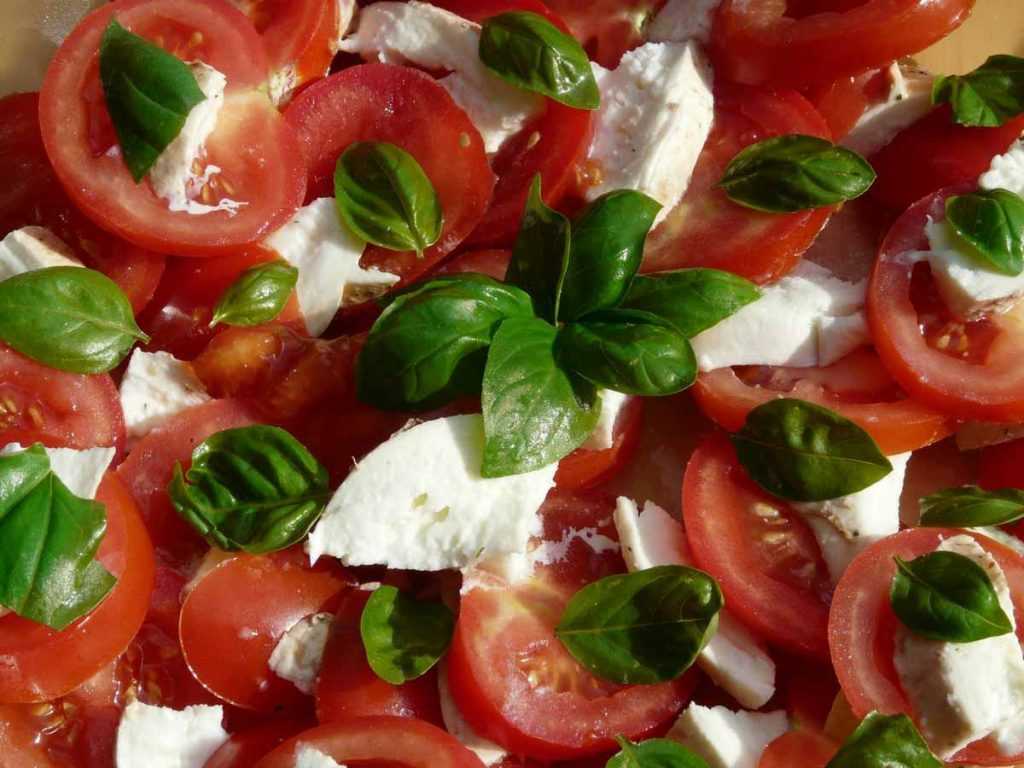
Tomato mozzarella and basil
- Pistou Soup
Pistou soup is a traditional recipe from Provence typically enjoyed during the summer. The soup consists of bacon with fresh shelled white and red beans and garden vegetables, usually green beans, carrots, courgettes, and potatoes. At the end of cooking, pistou is added, which gives this Provençal soup its distinctive character.
- Summer Tomato-Basil Salad from the Garden
Straight from the garden, pick some ripe tomatoes of different colours still warmed by the sun, slice them carpaccio-style, add chopped basil, a drizzle of quality olive oil, a pinch of fleur de sel, a twist of pepper, and here you have a delicious salad!
The benefits of basil
Basil stimulates digestion, and can be used as an infusion of leaves after a heavy meal.
It is rich in antioxidants, molecules that help slow down the ageing of cells and cardiovascular diseases. Regular consumption is beneficial for health.
Basil flowers contain an essential oil based on eucalyptol and eugenol. Its use helps combat anxiety and infections; it is an antispasmodic, anti-inflammatory, and antibacterial with calming and relaxing properties.
The holy basil used in Ayurvedic medicine is used in India for the prevention and healing of numerous ailments: gastric issues, diarrhoea, bacterial and fungal infections, inflammation, and headaches.
Producing your basil seeds
Basil requires a lot of heat to produce viable seeds. Therefore, as not all climates in mainland France are equal, seeds are mainly harvested in the South, in Provence, or possibly by cultivating under glass in the northern climates.
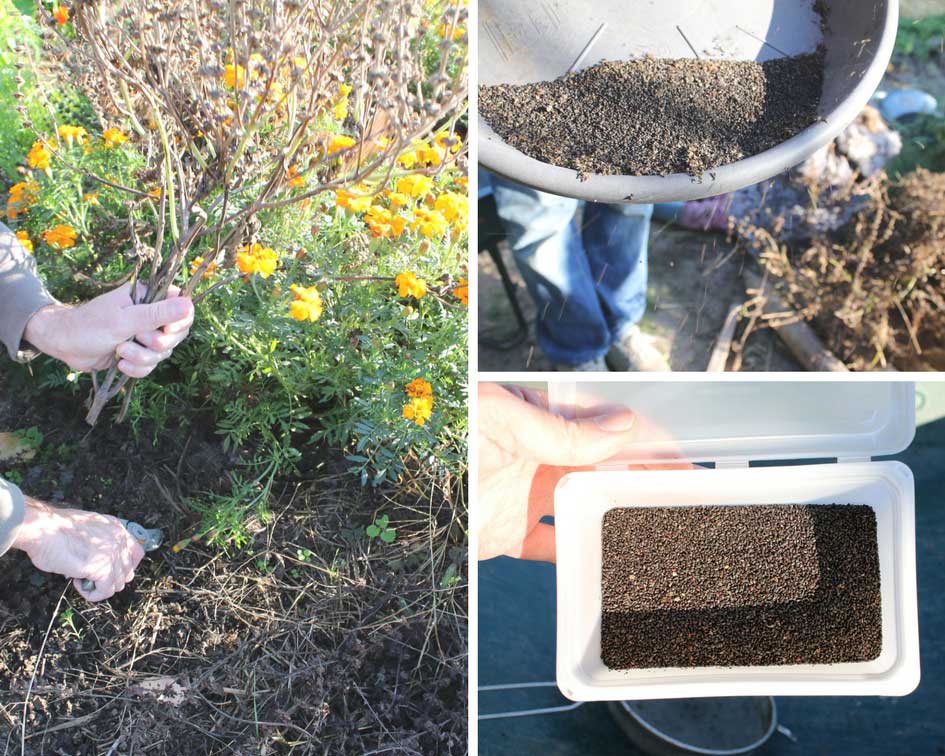
In case of a larger harvest, cut the dry plants entirely, sift, and then ventilate to separate the waste from the seeds. Store the seeds in non-airtight containers.
To avoid cross-breeding between two varieties, only one variety should be allowed to seed per year, or two varieties should be spaced at least 100 metres apart. In September and October, the flower spikes will dry out; they should be cut, and the receptacles should be rubbed between the fingers to release the seeds. It is advisable to avoid excessive leaf harvesting on plants intended for seed production, although one should ensure they are still flavourful.
Basil seeds should not be stored in airtight boxes but rather in paper bags. Indeed, basil seed is mucilaginous; when in contact with water or excessive humidity, mucilage will form around the seed. Mucilage is composed of sugars, and once it appears, it can dry, but the seed then becomes a gateway for the development of mould.
Useful resources
Discover:
- Our wide range of basil: many varieties are available as seeds or young plants.
- Learn more about sowing basil
- Our selection: 6 essential varieties of basil
- Perennial basil: a sustainable alternative to common basil
- Article: How to grow basil in pots?
- Article: Choosing basil: our buying guide
- Discover 8 aromatic plants for Mediterranean cuisine
Frequently asked questions
-
Why isn't my basil germinating?
It is quite possible for seeds not to germinate, even for the most experienced gardeners:
A seed is alive. The gardener must learn about the germination capacity, which is the duration during which the seed can germinate. This information is systematically mentioned on seed packets. For basil, it varies from 4 to 8 years depending on the quality of the seed, which largely depends on the year of the harvest.
Poor storage conditions for seeds lead to a decrease in germination capacity. Store your seed packets inside your home in a dry place, not too warm in summer, and away from sunlight.
Most vegetable and aromatic seeds have primarily two (sometimes more) essential needs for proper germination: sufficient temperature and humidity. The most important factor is to maintain a constant humidity level, neither excessive nor deficient. To achieve this, water sparingly and regularly during the germination period and continue as long as the plants are young. It is also essential to sow at the times indicated on the seed packets. Basil seeds have a third requirement; they like to receive light to germinate well (even under a few millimetres of soil).
Damping off is also a possible but rarer issue, caused by different species of pathogenous fungi that will kill young seedlings. This problem can be prevented by avoiding excessive watering and by sprinkling the sowing with charcoal or powdered cinnamon.
-
Why are the leaves of my basil turning black?
Basil leaves turn black when there is an excess of water at the root level. Basil is a plant that loves water but hates excess. This is why the soil (or substrate) must be sufficiently draining to evacuate water.
If this problem occurs in a pot culture, it is necessary to suspend watering for a while, and especially not to leave any residual water in the saucer. In open ground, this is a less common issue but can happen if the soil is too heavy. In this case, consider making your next plantings on light mounds or raised beds to drain water away from the roots more quickly.
- Subscribe!
- Contents































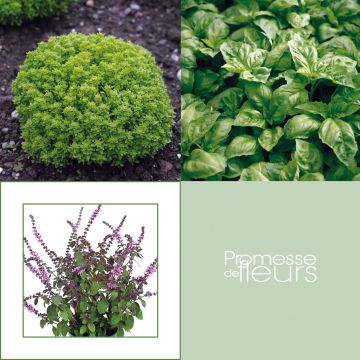
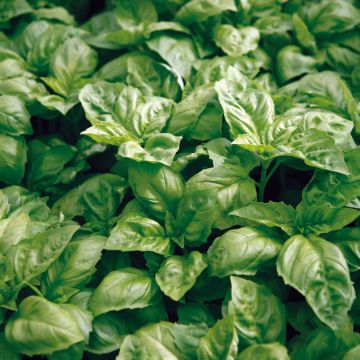


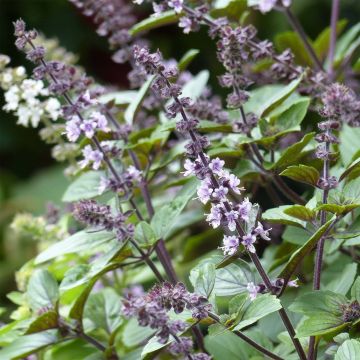
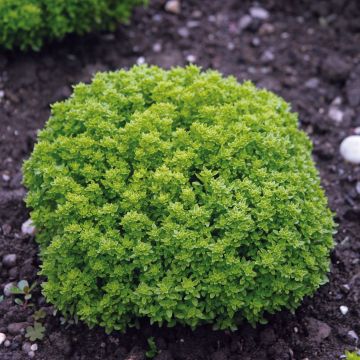
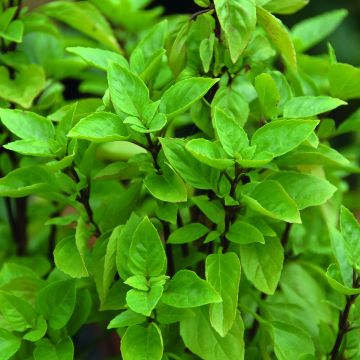
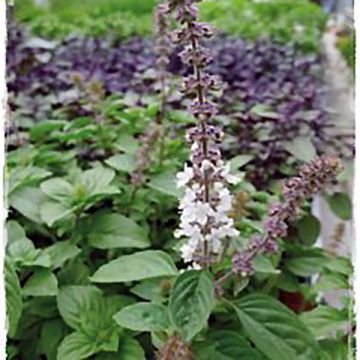
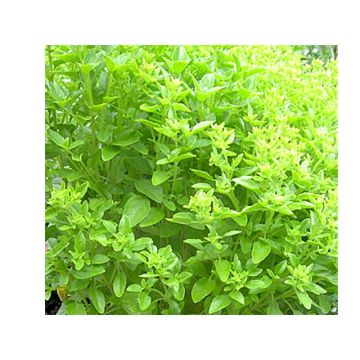
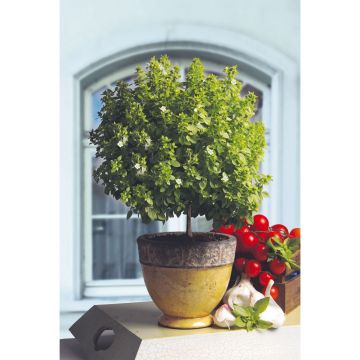
Comments